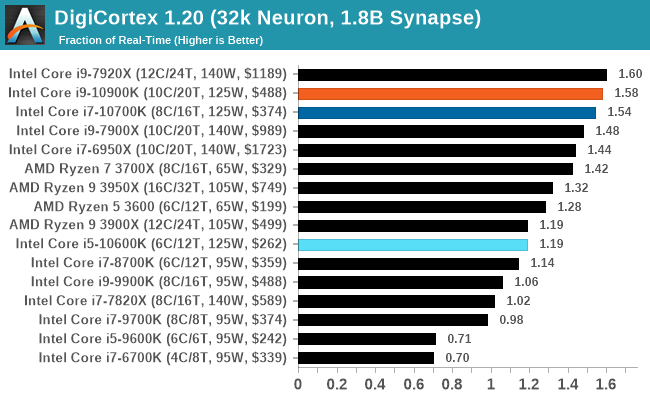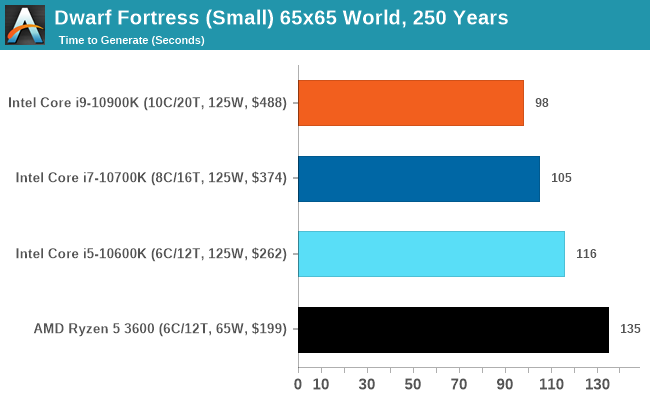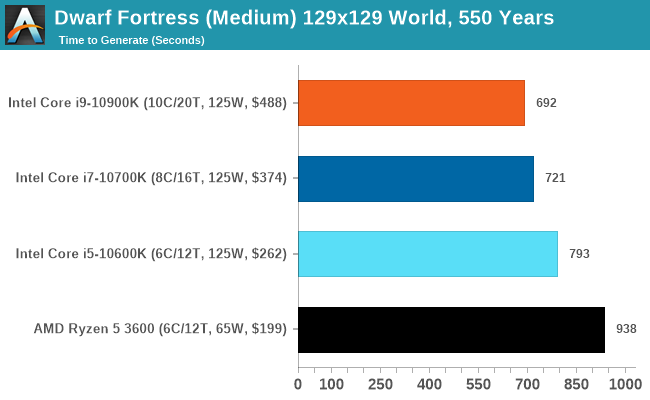The Intel Comet Lake Core i9-10900K, i7-10700K, i5-10600K CPU Review: Skylake We Go Again
by Dr. Ian Cutress on May 20, 2020 9:00 AM EST- Posted in
- CPUs
- Intel
- Skylake
- 14nm
- Z490
- 10th Gen Core
- Comet Lake
CPU Performance: Simulation Tests
A number of our benchmarks fall into the category of simulations, whereby we are either trying to emulate the real world or re-create systems with systems. In this set of tests, we have a variety including molecular modelling, non-x86 video game console emulation, a simulation of the equivalent of a slug brain with neurons and synapses firing, and finally a popular video game that simulates the growth of a fictional land including historical events and important characters within that world.
NAMD ApoA1
One frequent request over the years has been for some form of molecular dynamics simulation. Molecular dynamics forms the basis of a lot of computational biology and chemistry when modeling specific molecules, enabling researchers to find low energy configurations or potential active binding sites, especially when looking at larger proteins. We’re using the NAMD software here, or Nanoscale Molecular Dynamics, often cited for its parallel efficiency. Unfortunately the version we’re using is limited to 64 threads on Windows, but we can still use it to analyze our processors. We’re simulating the ApoA1 protein for 10 minutes, and reporting back the ‘nanoseconds per day’ that our processor can simulate. Molecular dynamics is so complex that yes, you can spend a day simply calculating a nanosecond of molecular movement.
This is one of our new tests, so we will be filling in more data as we start regression testing for older CPUs.

Dolphin 5.0: Console Emulation
One of the popular requested tests in our suite is to do with console emulation. Being able to pick up a game from an older system and run it as expected depends on the overhead of the emulator: it takes a significantly more powerful x86 system to be able to accurately emulate an older non-x86 console, especially if code for that console was made to abuse certain physical bugs in the hardware.
For our test, we use the popular Dolphin emulation software, and run a compute project through it to determine how close to a standard console system our processors can emulate. In this test, a Nintendo Wii would take around 1050 seconds.
The latest version of Dolphin can be downloaded from https://dolphin-emu.org/

DigiCortex 1.20: Sea Slug Brain Simulation
This benchmark was originally designed for simulation and visualization of neuron and synapse activity, as is commonly found in the brain. The software comes with a variety of benchmark modes, and we take the small benchmark which runs a 32k neuron / 1.8B synapse simulation, equivalent to a Sea Slug.
Example of a 2.1B neuron simulation
We report the results as the ability to simulate the data as a fraction of real-time, so anything above a ‘one’ is suitable for real-time work. Out of the two modes, a ‘non-firing’ mode which is DRAM heavy and a ‘firing’ mode which has CPU work, we choose the latter. Despite this, the benchmark is still affected by DRAM speed a fair amount.
DigiCortex can be downloaded from http://www.digicortex.net/

The additional bandwidth of the HEDT platforms put them higher up the chart here - Digicortex always ends up as an odd mix of bottlenecks mostly around memory, but it can be localized internal bandwidth limited as well.
Dwarf Fortress
Another long standing request for our benchmark suite has been Dwarf Fortress, a popular management/roguelike indie video game, first launched in 2006. Emulating the ASCII interfaces of old, this title is a rather complex beast, which can generate environments subject to millennia of rule, famous faces, peasants, and key historical figures and events. The further you get into the game, depending on the size of the world, the slower it becomes.
DFMark is a benchmark built by vorsgren on the Bay12Forums that gives two different modes built on DFHack: world generation and embark. These tests can be configured, but range anywhere from 3 minutes to several hours. I’ve barely scratched the surface here, but after analyzing the test, we ended up going for three different world generation sizes.
This is another of our new tests.














220 Comments
View All Comments
watzupken - Wednesday, May 20, 2020 - link
Sorry for typo, its a 28 core, not 20 core.blaktron - Wednesday, May 20, 2020 - link
No one else wondering how Ian manages to get only a 5% drop in performance going from h264 Faster to h265 Fast? That should be well over a 50% drop, and suggests he is running his HEVC tests with an H264 profile.Am I crazy here or is the idea that an 8 core CPU gets 200 fps h265/HEVC encoding just plain wrong?
WaWaThreeFIVbroS - Thursday, May 21, 2020 - link
This place is owned by the dudes running tomshardware, what do u expectIcehawk - Saturday, May 23, 2020 - link
I have asked numerous times how they get HEVC #s as they are almost quadruple what I get. 3900x gets in the 70s encoding and my 8700 was in the 60s. I can only guess they use the hardware encoders which isn’t how anyone who cares about quality is going to do it and doesn’t show the full cpu vs cpu difference, it shows the built in encoder. But Anand still thinks people who bother to read CPU reviews don’t use XMP.lucasdclopes - Wednesday, May 20, 2020 - link
"Intel's turbo has a recommended length of 56 seconds according to the specification sheets, and on our test system here, the motherboard manfuacturer is confident that its power delivery can support a longer-than-56 second turbo time. "So performance of those chips will have significant differences depending on the motherboard? Maybe cheaper boards will result in worse sustained performance then.
jcc5169 - Wednesday, May 20, 2020 - link
Intel fanboys are gasping for air, looking for excuses not to buy the obvious choice, AMDDannyH246 - Wednesday, May 20, 2020 - link
www.IntelTech.com does it again!! Every element designed to show Intel in the best possible way.How about this instead...
The Core i9-10900K's is priced so that its clear competitor is the Ryzen 9 3900X. However AMD offering is still >=15% cheaper, offers PCIe 4.0 compatibility, uses less power, is more secure and can be used on older, cheaper boards that also support the 16-core 3950X allowing for an upgrade path. The Core i9 is a moderately reasonable chip at best, however as it requires a new motherboard it is effectively a dead end.
vanilla_gorilla - Wednesday, May 20, 2020 - link
I always know it's a good review when half of the comments claim the author is an Intel shill and the other half claim they are an AMD shill.Beany2013 - Wednesday, May 20, 2020 - link
Ain't it beautiful?Honestly, I'm kinda surprised how well Intel has managed to maintain their performance on a pure math basis, but oh *goodness* that power usage.
I think things will get really interesting when intel hit the sub 10nm* process (by which time AMD should be on 5nm*) and we'll see how much fight both Intel and AMD both have.
That it means we can all get solid multicore, multithread (fucking finally) CPUs from both vendors at prices that can be described as 'not entirely crazy' is a win win no matter which side of the fence you're on.
Steven R
Beany2013 - Wednesday, May 20, 2020 - link
* yeah, nm is a bit of a poor measurement these days, but you get the idea.